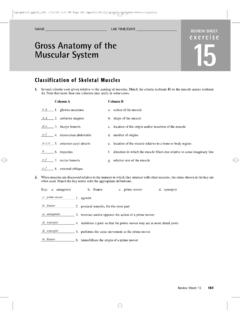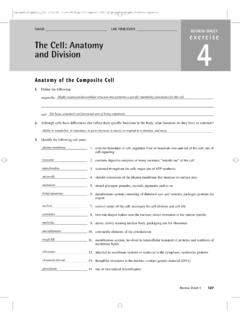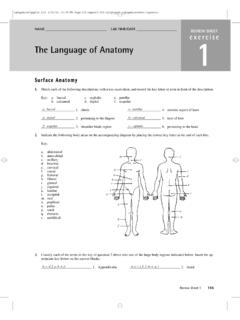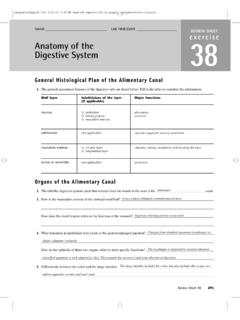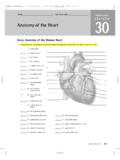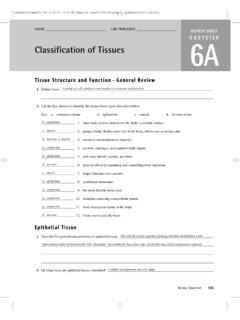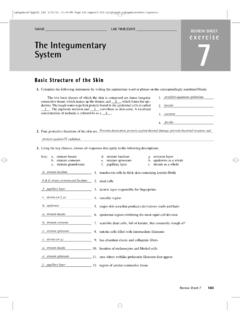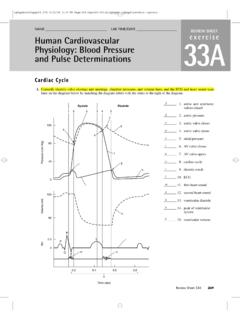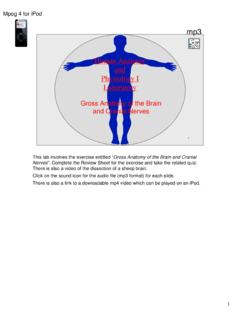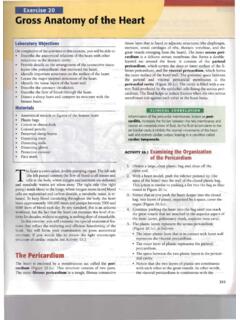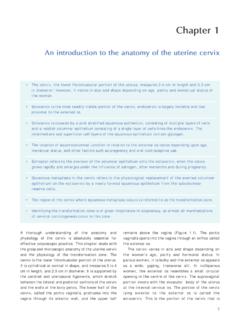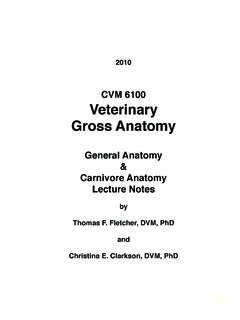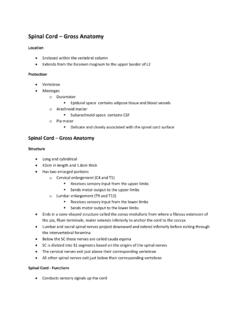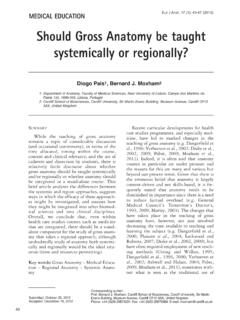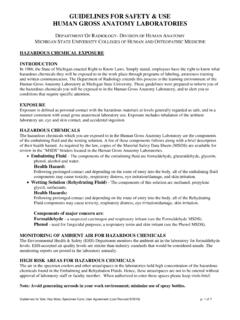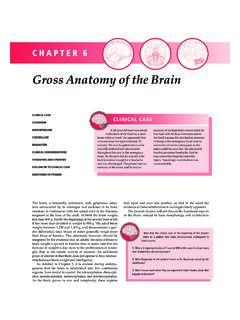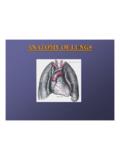Transcription of NAME LAB TIME/DATE REVIEW SHEET Gross …
1 IghapmLre19pg203_208 5/12/04 1:16 PM Page 203 impos03 302:bjighapmL:ighapmLrevshts:layouts: NAME _____ LAB TIME/DATE _____. REVIEW SHEET . exercise Gross anatomy of the brain and cranial Nerves The Human brain 19. 1. Match the letters on the diagram of the human brain (right lateral view) to the appropriate terms listed at the left: h 1. frontal lobe f a b 2. parietal lobe g b j 3. temporal lobe c h f 4. precentral gyrus d i c 5. parieto-occipital j sulcus a 6. postcentral gyrus e k i 7. lateral sulcus l 10. medulla l g 8. central sulcus d 11. occipital lobe e 9. cerebellum k 12. pons 2. In which of the cerebral lobes would the following functional areas be found? auditory area temporal olfactory area temporal primary motor area frontal visual area occipital primary sensory area parietal Broca's area frontal 3. Which of the following structures are not part of the brain stem? (Circle the appropriate response or responses.)
2 Cerebral hemispheres pons midbrain cerebellum medulla diencephalon 4. Complete the following statements by writing the proper word or phrase on the corresponding blanks at the right. A(n) 1 is an elevated ridge of cerebral tissue. The convolu- 1. gyrus tions seen in the cerebrum are important because they increase the 2 . Gray matter is composed of 3 . White matter is com- 2. surface area posed of 4 . A fiber tract that provides for communication be- tween different parts of the same cerebral hemisphere is called a(n) 3. neuron cell bodies 5 , whereas one that carries impulses to the cerebrum from, and from the cerebrum to, lower CNS areas is called a(n) 6 tract. myelinated fibers The lentiform nucleus along with the amygdaloid and caudate nuclei 4. are collectively called the 7 . 5. association tract 6. projection 7. basal nuclei REVIEW SHEET 19 203. ighapmLre19pg203_208 5/12/04 1:16 PM Page 204 impos03 302:bjighapmL:ighapmLrevshts:layouts: 5.
3 Identify the structures on the following sagittal view of the human brain by matching the numbered areas to the proper terms in the list. 18 a. cerebellum 1 10 11. 15 b. cerebral aqueduct 2 12. 1 c. cerebral hemisphere 3 13. 14 4 14. d. cerebral peduncle 10 5 15. e. choroid plexus 13 6 16. f. corpora quadrigemina 7 17. 2 g. corpus callosum 8 18. 4 h. fornix 16 9 19. i. fourth ventricle 6 j. hypothalamus 8 k. mammillary bodies 7 n. optic chiasma 17 q. pons 5 l. massa intermedia 12 o. pineal body 3 r. septum pellucidum 19 m. medulla oblongata 9 p. pituitary gland 11 s. thalamus 6. Using the terms from item 5, match the appropriate structures with the descriptions given below: j 1. site of regulation of body temperature and water balance; most important autonomic center c 2. consciousness depends on the function of this part of the brain f 3. located in the midbrain; contains reflex centers for vision and audition a 4.
4 Responsible for regulation of posture and coordination of complex muscular movements s 5. important synapse site for afferent fibers traveling to the sensory cortex m 6. contains autonomic centers regulating blood pressure, heart rate, and respiratory rhythm, as well as coughing, sneezing, and swallowing centers g 7. large commissure connecting the cerebral hemispheres h 8. fiber tract involved with olfaction b 9. connects the third and fourth ventricles s 10. encloses the third ventricle 204 REVIEW SHEET 19. ighapmLre19pg203_208 5/12/04 1:16 PM Page 205 impos03 302:bjighapmL:ighapmLrevshts:layouts: 7. Embryologically, the brain arises from the rostral end of a tubelike structure that quickly becomes divided into three major regions. Groups of structures that develop from the embryonic brain are listed below. Designate the embryonic origin of each group as the hindbrain, midbrain, or forebrain.
5 Forebrain 1. the diencephalon, including the thalamus, optic chiasma, and hypothalamus hindbrain 2. the medulla, pons, and cerebellum forebrain 3. the cerebral hemispheres 8. What is the function of the basal nuclei? They are involved in the regulation, modulation, and refinement of voluntary motor activity. 9. What is the corpus striatum, and how is it related to the fibers of the internal capsule? The fibers of the internal capsule pass between the basal nuclei, giving them a striped appearance; therefore, a striped body or corpus striatum. 10. A brain hemorrhage within the region of the right internal capsule results in paralysis of the left side of the body. Explain why the left side (rather than the right side) is affected. Because most of the motor fibers cross over to the opposite side at the level of the medulla oblongata. 11. Explain why trauma to the base of the brain is often much more dangerous than trauma to the frontal lobes.
6 (Hint: Think about the relative functioning of the cerebral hemispheres and the brain stem structures. Which contain centers more vital to life?). Trauma to the base of the brain might damage the medulla oblongata, which contains vital respiratory, cardiac, and vasomotor centers. Also, the reticular activating system, which helps to maintain consciousness, spans the length of the brain stem. 12. In split brain experiments, the main commissure connecting the cerebral hemispheres is cut. First, name this commissure: Corpus callosum Then, describe what results (in terms of behavior) can be anticipated in such experiments. (Use an appropriate reference if you need help with this one!). The disconnection of verbal naming and mathematical functions of the left side of the brain from the spatial recognition abilities of the right side ( associating names with faces); some patients report that they no longer dream; isolated patients are mute for a brief time after surgery and have difficulty controlling the left side of the body.
7 REVIEW SHEET 19 205. ighapmLre19pg203_208 5/12/04 1:16 PM Page 206 impos03 302:bjighapmL:ighapmLrevshts:layouts: Meninges of the brain 13. Identify the meningeal (or associated) structures described below: dura mater 1. outermost meninx covering the brain ; composed of tough fibrous connective tissue pia mater 2. innermost meninx covering the brain ; delicate and highly vascular arachnoid villi 3. structures instrumental in returning cerebrospinal fluid to the venous blood in the dural sinuses choroid plexus 4. structure that forms the cerebrospinal fluid arachnoid mater 5. middle meninx; like a cobweb in structure dura mater 6. its outer layer forms the periosteum of the skull falx cerebri 7. a dural fold that attaches the cerebrum to the crista galli of the skull tentorium cerebelli 8. a dural fold separating the cerebrum from the cerebellum Cerebrospinal Fluid 14. Fill in the following flowchart by delineating the circulation of cerebrospinal fluid from its formation site (assume that this is one of the lateral ventricles) to the site of its reabsorption into the venous blood: Lateral ventricle interventricular Third ventricle.
8 Foramen median foramen .. cerebral aqueduct fourth ventricle lateral foramen .. central canal subarachnoid space arachnoid villi dural sinuses (surrounding the (containing brain and spinal cord) venous blood). Now label appropriately the structures involved with circulation of cerebrospinal fluid on the accompanying diagram. (These structures are identified by leader lines.). Lateral ventricle Third ventricle Interventricular Cerebral aqueduct foramen Fourth ventricle Lateral aperture 206 REVIEW SHEET 19. ighapmLre19pg203_208 5/12/04 1:16 PM Page 207 impos03 302:bjighapmL:ighapmLrevshts:layouts: cranial Nerves 15. Using the terms below, correctly identify all structures indicated by leader lines on the diagram. a. abducens nerve (VI) j. longitudinal fissure s. pituitary gland b. accessory nerve (XI) k. mammillary body t. pons c. cerebellum l. medulla oblongata u. spinal cord d. cerebral peduncle m.
9 Oculomotor nerve (III) v. temporal lobe of cerebral hemisphere e. decussation of the pyramids n. olfactory bulb w. trigeminal nerve (V). f. facial nerve (VII) o. olfactory tract x. trochlear nerve (IV). g. frontal lobe of cerebral hemisphere p. optic chiasma y. vagus nerve (X). h. glossopharyngeal nerve (IX) q. optic nerve (II). z. vestibulocochlear nerve (VIII). i. hypoglossal nerve (XII) r. optic tract j n g o q s p v m x r d k w f t z a h c y l b i e u REVIEW SHEET 19 207. ighapmLre19pg203_208 5/12/04 1:16 PM Page 208 impos03 302:bjighapmL:ighapmLrevshts:layouts: 16. Provide the name and number of the cranial nerves involved in each of the following activities, sensations, or disorders: accessory (XI) 1. shrugging the shoulders olfactory (I) 2. smelling a flower oculomotor (III) 3. raising the eyelids; focusing the lens of the eye for accommoda- tion; and pupillary constriction vagus (X) 4.
10 Slows the heart; increases the mobility of the digestive tract facial (VII) 5. involved in Bell's palsy (facial paralysis). trigeminal (V) 6. chewing food vestibulocochlear (VIII) 7. listening to music; seasickness facial (VII) 8. secretion of saliva; tasting well-seasoned food III, IV, VI 9. involved in rolling'' the eyes (three nerves provide numbers only). trigeminal (V) 10. feeling a toothache optic (II) 11. reading Mad magazine I, II, VIII 12. purely sensory in function (three nerves provide numbers only). Dissection of the Sheep brain 17. In your own words, describe the firmness and texture of the sheep brain tissue as observed when cutting into it. Very soft; much like thickened oatmeal in consistency. Because formalin hardens all tissue, what conclusions might you draw about the firmness and texture of living brain tissue? It must be very soft and fragile. 18. Compare the relative sizes of the cerebral hemispheres in sheep and human brains?
